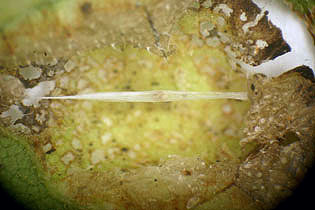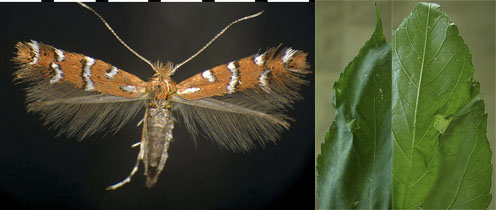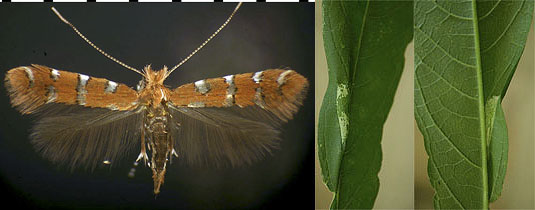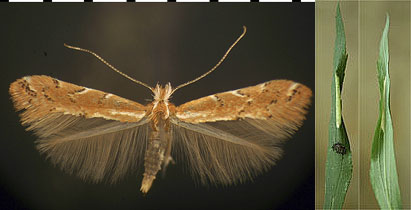
Larvae of all species of Cremastobombycia make underside tentiform mines on various species of composites (Asteraceae), usually at open edges of deciduous forest. Leaf mines of all species are commonest in July and August. When larval feeding is completed, pupation occurs inside the mine, inside a suspended, spindle-shaped white silken cocoon (Fig. 1). Adults are rust-colored moths with silvery-white markings on the forewing; the white markings are bordered with black on their apical (outer) margins. Three of the five described North American species of Cremastobombycia occur in Illinois.

Figure 1. Cremastobombycia ambrosiaeella, cocoon, in leaf mine on giant ragweed, Ambrosia trifida (Asteraceae).
Cremastobombycia ambrosiaeella (Fig. 2) is the smallest of the three species. The larva feeds in a small, almost circular mine on ragweeds (Ambrosia); usually on giant ragweed, A trifida, but occasionally on common ragweed, A. artemisiifolia.

Figure 2. Cremastobombycia ambrosiaeella. Adult, and leaf mine on giant ragweed, Ambrosia trifida (Asteraceae).
Cremastobombycia ignota (Fig. 3) feeds in a somewhat elongate mine on wingstem, Verbesina alternifolia.

Figure 3. Cremastobombycia ignota. Adult, and leaf mine on wingstem, Verbesina alternifolia (Asteraceae).
Cremastobombycia solidaginis (Fig. 4) feeds in an elongate mine on goldenrod, Solidago sp.

Figure 4. Cremastobombycia solidaginis. Adult, and leaf mine on goldenrod, Solidago sp. (Asteraceae).